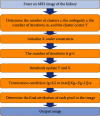Correlation between Blood Oxygen Level-Dependent Magnetic Resonance Imaging Images and Prognosis of Patients with Multicenter Diabetic Nephropathy on account of Artificial Intelligence Segmentation Algorithm
- PMID: 35860185
- PMCID: PMC9293502
- DOI: 10.1155/2022/5700249
Correlation between Blood Oxygen Level-Dependent Magnetic Resonance Imaging Images and Prognosis of Patients with Multicenter Diabetic Nephropathy on account of Artificial Intelligence Segmentation Algorithm
Abstract
This study was aimed to analyze the correlation between blood oxygen level-dependent magnetic resonance imaging (BOLD-MRI) images and prognosis of patients with diabetic nephropathy (DN) based on artificial intelligence (AI) segmentation algorithm, so as to provide references for diagnosis and treatment as well as prognosis analysis of patients DN. In this study, a kernel function-based fuzzy C-means algorithm (KFCM) model was proposed, and the FCM algorithm based on neighborhood pixel information (BCFCM) and the FCM algorithm based on efficiency improvement (EnFCM) were introduced for comparison to analyze the image segmentation effects of three algorithms. The results showed that the partition coefficient (Vpc) and partition entropy (Vpe) of the KFCM algorithm were 0.801 and 0.602, respectively, which were better than those of the traditional FCM, BCFCM, and EnFCM algorithm. At the same time, the effects of correlation between renal cortex R2∗ (RC-R2∗), renal medulla R2∗ (RM-R2∗), renal cortex D (RC-D), renal medulla D (RM-D) and renal function on the prognosis were compared. The results showed that the correlation coefficients between RC-R2∗, RM-R2∗, RC-D, RM-D and renal function were 0.57, 0.62, 0.49, and 0.38, respectively; among them, RC-R2∗ and RM-R2∗ were negatively correlated to the estimated glomerular filtration rate (eGFR), and the difference between the groups was statistically significant (P <0.05). Among the factors affecting the prognosis of DN patients, the GFR, hemoglobin (Hb), RC-R2∗, RM-R2∗, and RC-D were all related to the prognosis of DN, and the difference between groups was statistically obvious (P <0.05). It suggested that the KFCM algorithm proposed in this study showed the relatively best segmentation effect on BOLD-MRI images for DN patients; an increase in R2∗ indicated a poor prognosis, and an increase in the RC-D value indicated a better prognosis.
Copyright © 2022 Yifan Zhang et al.
Conflict of interest statement
The authors declare no conflicts of interest.
Figures







Similar articles
-
Optimized Fuzzy C-Means Algorithm-Based Coronal Magnetic Resonance Imaging Scanning in Tracheal Foreign Bodies of Children.J Healthc Eng. 2021 Jul 7;2021:5678994. doi: 10.1155/2021/5678994. eCollection 2021. J Healthc Eng. 2021. PMID: 34306593 Free PMC article.
-
Evaluation of Functional Magnetic Resonance Imaging under Artificial Intelligence Algorithm on Plan-Do-Check-Action Home Nursing for Patients with Diabetic Nephropathy.Contrast Media Mol Imaging. 2022 Mar 25;2022:9882532. doi: 10.1155/2022/9882532. eCollection 2022. Contrast Media Mol Imaging. 2022. PMID: 35399221 Free PMC article. Clinical Trial.
-
Diagnosis and Nursing Intervention of Gynecological Ovarian Endometriosis with Magnetic Resonance Imaging under Artificial Intelligence Algorithm.Comput Intell Neurosci. 2022 Jun 11;2022:3123310. doi: 10.1155/2022/3123310. eCollection 2022. Comput Intell Neurosci. 2022. PMID: 35726287 Free PMC article. Clinical Trial.
-
Methods of Blood Oxygen Level-Dependent Magnetic Resonance Imaging Analysis for Evaluating Renal Oxygenation.Kidney Blood Press Res. 2018;43(2):378-388. doi: 10.1159/000488072. Epub 2018 Mar 8. Kidney Blood Press Res. 2018. PMID: 29539614 Review.
-
Lessons learned from studies of the natural history of diabetic nephropathy in young type 1 diabetic patients.Pediatr Endocrinol Rev. 2008 Aug;5 Suppl 4:958-63. Pediatr Endocrinol Rev. 2008. PMID: 18806710 Review.
Cited by
-
Neuroimaging studies of resting-state functional magnetic resonance imaging in eating disorders.BMC Med Imaging. 2024 Oct 7;24(1):265. doi: 10.1186/s12880-024-01432-z. BMC Med Imaging. 2024. PMID: 39375605 Free PMC article. Review.
References
Publication types
MeSH terms
Substances
LinkOut - more resources
Full Text Sources
Medical
Research Materials
Miscellaneous

